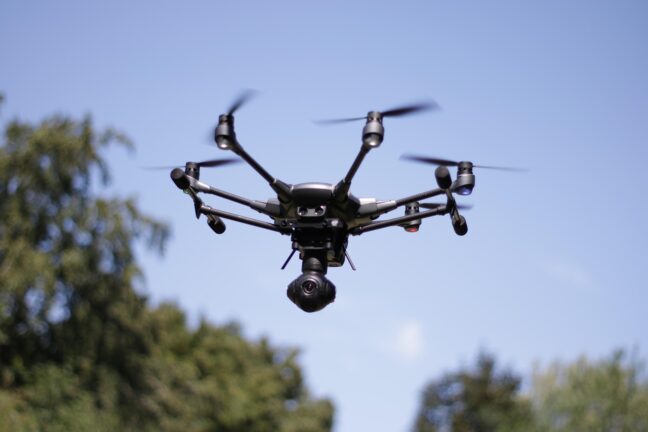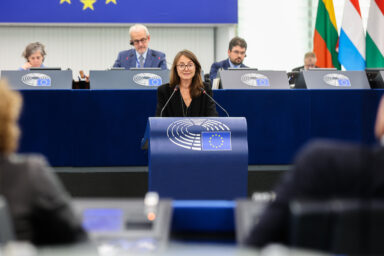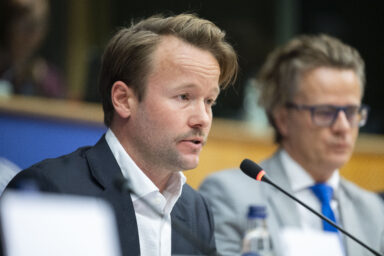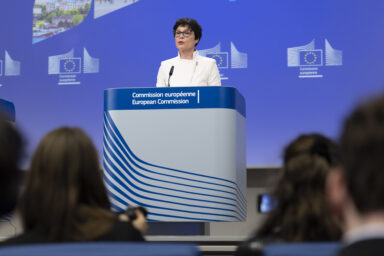Commission President Ursula von der Leyen has pleaded with MEPs for EU defence unity in face of continuing Russian provocations, and the Council agreed to speed up military investments. But the central piece of the puzzle went missing, as the European Defence Industry Programme fell victim to diverging interests and EU institutional squabbles on Tuesday.
Russian drones are all the rage now. In Strasbourg on Wednesday, 8 October, Ursula von der Leyen, president of the European Commission, told MEPs that the pattern of Russian (and possibly other) UAVs violating EU and NATO airspace “is a coherent and escalating campaign to unsettle our citizens, test our resolve, divide our Union, and weaken our support for Ukraine.” “This is hybrid warfare,” she said, and warned that Europe must “meet it with unity, deterrence and resolve”.
Ms von der Leyen argued that Europe must rethink its defence playbook, blending classic deterrence with technology able to counter sub-threshold threats. She did not name Russia as the culprit behind every incident, but she made clear that Moscow’s aim is to “sow division” within the 27-member bloc.
Partly in response to Ms von der Leyen’s urging, the Parliament’s plenary agreed a resolution on Wednesday morning, calling “on the Commission and the Council to develop an action plan of measures preventing and countering the escalation of Russian hybrid warfare against the EU in terrestrial, aerial, maritime and digital domains“. It also condemned Russian drone provocations as state-sponsored terrorism, even if they do not quite qualify as a full-scale military attack.
You might be interested
A prompt from the Council
At about the same time on Wednesday morning, member state representatives agreed their position on ReArm Europe, a plan to expand defence-related spending by tweaking five EU programmes, from Horizon Europe to the Connecting Europe Facility. Marie Bjerre, Denmark’s minister for European affairs, explained the objective: “With the Council’s agreed position, we want to open key EU programmes to more defence-related investments, and we are enabling a more agile and coordinated effort to strengthen Europe’s Defence Industrial and Technological Base,” or EDTIB.
The Council wants Horizon Europe to admit dual-use projects on the same footing as purely civilian research, aligning it with the European Defence Fund and a new Strategic Technologies for Europe Platform. The amendments would let firms seek money for encryption software or drone-swarm algorithms without rewriting proposals to purge military references.
ReArm is meant to sit beside the “defence readiness omnibus” package presented by the Commission in June. Both initiatives were requested by EU leaders in March and aim to raise the bloc’s combat mass by 2030. Negotiations with Parliament on ReArm are expected to start shortly; officials hope to close the file before year-end.
Stuck in trilogue
That development contrasts sharply with the fate of the European Defence Industry Programme (EDIP), a €1.5bn plan intended to knit the continent’s arms factories into a single market. A trilogue on Tuesday, October 7th, ended without agreement, as EU Perspective source confirmed. The offices of parliamentary co-rapporteurs, Raphaël Glucksmann (S&D/FRA) and François-Xavier Bellamy (EPP/FRA) did not immediately respond to EU Perspectives queries.
The proposals significantly shift responsibility for defence to the shared, European level. They are also posited as the basis for all future EU defence expenditure. In other words, EDIP is the executive hammer for the wider EDTIB programme.
This is hybrid warfare. Europe must meet it with unity, deterrence and resolve. — European Commission President Ursula von der Leyen
While EDTIB represents the actual industrial and technological ecosystem of defence-related actors—the manufacturers, R&D centres, and suppliers—EDIP is the EU’s policy and funding tool crafted to develop this base. EDIP supports the EDTIB by directing financial resources, coordinating projects, and prioritising areas crucial to Europe’s defence ambitions in reaction to evolving security challenges.
The base and its booster
EDIP matters because it is designed to reinforce the European Defence Technological and Industrial Base, or EDTIB—the network of firms, laboratories and supply chains that design and build Europe’s weapons. The EDTIB is the industrial reality; EDIP is the policy tool that funnels cash, sets common standards and pushes national orders into joint projects.
Without the EDTIB, EDIP would have no ground to cultivate. Without EDIP, the EDTIB risks remaining fragmented and vulnerable to foreign pressure. The programme would also introduce the Structure for European Armament Programme, forcing groups of countries to buy equipment together and adopt harmonised specifications. Ukraine would join the scheme on the same terms as EU members, a political step unthinkable a few years ago.
ReArm, by comparison, only tweaks existing pots of money and avoids questions of sovereignty. Its smooth passage through the Council therefore highlights the size of the EDIP impasse. If governments can agree overnight to open Horizon Europe to dual-use research, why is it so hard to finalise EDIP? Size and symbolism are the answers. ReArm moves cash already in the system; EDIP would reshape how Brussels and capitals share power over armaments.
Public doubts
That, along with the growing urgency of all defence matters, is why Wednesday‘s stalemate raised many an eyebrow. Other media outlets reflected it. “Parliament does not seem to understand that this is not some regular legislative file that they can play politics with,” an EU diplomat told Politico. Meanwhile, Euractiv argued that MEPs are “torpedoing Europe’s greatest chance of securing real influence over defence spending decisions”.
It appeared that budget and eligibility rules were the main sticking point. All sides think the fund is too small but without agreement where fresh money should come from. Parliament insists that only projects under EU control of intellectual-property rights deserve cash, while governments want missiles and ammunition made under foreign licences to remain eligible.
We want to open key EU programmes to more defence-related investments. — Marie Bjerre, Denmark’s minister for European affairs
Added pressure comes from poll numbers. A Polling Europe survey released on Tuesday day showed that 52 per cent of respondents doubt the continent’s military preparedness; support for higher defence spending has fallen by seven percentage points since the last poll, taken before Russian drones violated Polish airspace. The numbers underline how far leaders still have to travel to convince voters that greater outlays on security are worth the cost.
Drones do not wait
When half the electorate doubts military readiness and support for higher budgets ebbs, parliamentarians grow wary of endorsing big new funds. Yet the same voters also worry about drones, disinformation and sabotage—and expect protection. Leaders must explain why programmes with opaque acronyms offer tangible security.
Ms von der Leyen linked the issues in her Strasbourg speech, arguing that counter-drone sensors, cyber shields and secure chips will stem from the very industrial base that EDIP seeks to strengthen. Her case now depends on negotiators finding a compromise on cash and licensing before the European Council meets later this month. They are to reconvene next week.
Should the talks fail again, ReArm will continue, and the defence readiness omnibus may pass in due course. But Europe’s flagship attempt to pool procurement and tighten supply chains would remain in limbo. Hybrid threats, meanwhile, are unlikely to pause while legislators argue. Drones will not wait for EU institutional squabbles to sort themselves out.










